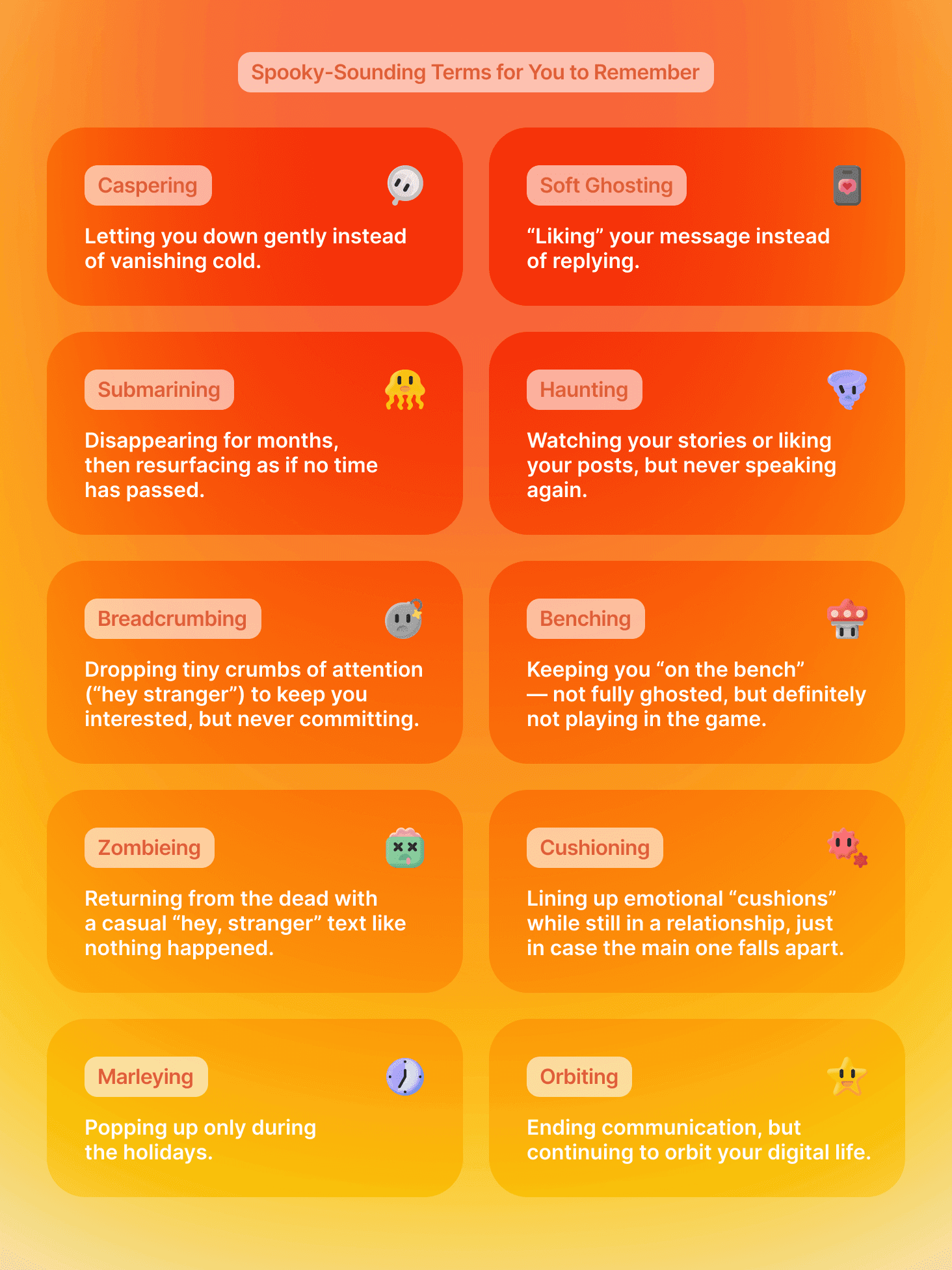5 Types of Ghosting: Why You Disappear and How to Heal

Ghosting is often a sign of something deeper. Behind every sudden silence, there’s usually fear, overwhelm, or confusion hiding beneath the surface. Sometimes people ghost because they act on impulse and can’t handle strong or uncomfortable feelings. For many, disappearing feels like the easiest way to escape discomfort, but over time, it costs one growth and connection.
There is no blame or finger-pointing in this article. It’s about self-awareness and how to develop coping strategies built on honesty and healthy communication.
Let’s uncover what drives the vanishing act and how to finally stop disappearing when things get hard.
Key Learnings
- Ghosting is more often an act of emotional self-protection than a deliberate act of unkindness.
- There are 5 main ghosting types, each rooted in fear, guilt, or exhaustion.
- Self-regulation and communication skills are key to changing the habit.
Why People Ghost Even When They Don’t Mean To
Ghosting is far more about the ghoster’s inner world than the person they ghost. Here is why people ghost beyond the simplest reasons like hectic life or "too much work."
#1: Emotional avoidance and overwhelm turn into a slow fade
It all starts with “I’ll reply later.” They might be waiting for the right moment, a less busy day, or a better mood. But then, the notifications pile up, and that one message they planned to answer later gets lost in the digital abyss.
However, studies show that people who ghost often care more about the situation that those who've been ghosted by them might think.
#2: They’re having a digital dating overload on social media
Blame it on the apps that turn one’s dating life into a never-ending texting with multiple people simultaneously. It’s easy to lose track of conversations, fall for novelty, or get distracted by the next “maybe” on the dating scene.
One Tinder study found that all of this can lead to emotional and decision fatigue, causing the brain to essentially shut down when everything starts to feel overwhelming.
#3: They don’t know how to self-regulate and self-soothe
Many people ghost because no one taught them how to deal with intense emotions. When emotional flooding hits during the conversation, they start overthinking and shut down. This shutdown can take different shapes.
You’ve probably heard of active and passive aggression but there’s a lesser-known, more complex form called annihilatory aggression. It happens when someone feels anger they can’t express directly, so instead of confronting or communicating, they emotionally erase the other person from their inner world. Rather than argue or explain, they withdraw completely, leaving the other person feeling invisible, powerless, and confused.
All in all, emotional avoidance helps disengage from unpleasant situations. The research proves it: in one of the studies, most participants who ghosted said they mostly felt guilty but also relieved.
#4: They have an avoidant or disorganized attachment style
Our attachment style forms during early childhood. To put it simply, the way we bonded with our caregivers shapes the way we bond with others as adults.
If the caregiver showed love, affection, and attunement to our needs and emotions, we learned that the world is a safe place and that we can trust others — we feel secure. For securely attached individuals, open and honest communication feels natural, which is why research finds they’re less likely to ghost others.
But if the caregiver was inconsistent, excessively controlling, or neglected the child, that person learned they couldn’t rely on others. As a result, they may avoid emotional closeness (avoidant attachment style) or alternate between seeking and rejecting it (disorganized attachment style).
People who tend to avoid closeness in relationships are more likely to ghost and close relationships with an abrupt end.
#5: They have poor communication skills
Not everyone learns how to express disappointment, set expectations, or say, “I’m not interested anymore,” in a kind but direct way because they don’t know how to express their needs with clarity.
Studies suggest that individuals ghost in modern relationships because it’s easier and safer and they don’t want a fight or an awkward talk.
5 Types of Ghosting and Why They Happen
Not all ghosting comes from bad intentions. Some vanish out of fear, others from confusion or emotional burnout. But every type has something to teach us about the ways we protect ourselves when vulnerability feels unsafe.

1. The Anxious Ghost
When in a romantic relationship, they often read between the lines of every text or emoji and try to guess the intentions of the other. They also might retreat before that other person can hurt them when their anxiety peaks.
Typical Ghosting Behavior
The Anxious Ghost is the master of soft ghosting. They tend to slow-fade and reply less frequently till the communication fully fades away.
The Deeper Why
These are often individuals with an anxious or disorganized attachment style who fear the possibility of rejection and have troubles with self-confidence.
The "i-am-not-good–enough" feeling often stems from one’s past traumas and inconsistent caregiving.
Quick Tips for Growth
- Label your feelings. Message the person you’re talking to with “I’m feeling overwhelmed. I need some time to calm down.” This way, you’re not leaving the person confused and showing respect with transparency;
- Get out of your imagination and ground yourself in facts. Anxious thinkers often jump to catastrophic conclusions. Challenge the narrative: “Are they no longer interested or just busy?”;
- Learn emotional regulation skills. Simple daily practices like journaling, mindfulness, or gentle movement (such as walking) can calm your body’s stress response and bring clarity. The Liven app brings these tools together in one place: you can capture your thoughts in a guided journal, talk through your emotions with Livie, the in-app AI companion, or explore science-backed lessons designed to help you manage anxiety and build emotional resilience.

2. The Highly Avoidant Ghost
These people often showcase the most emotionally unavailable behaviors to maintain distance and control. The Highly Avoidant Ghosts might describe themselves as independent and highly self-sufficient. They resist vulnerability and prefer distance when in a romantic relationship.
Typical Ghosting Behavior
This category has the most diverse ghosting behaviors.
- Haunting. They might have disappeared once, but now, weeks or months after, they watch your Instagram stories and like your posts but never engage directly with you;
- Breadcrumbing. They engage with no-substance messages like flattering comments occasionally to keep one interested, but this never leads to real connection;
- Benching. They keep one as a "backup" in case their main dating option falls through.
Sometimes, these individuals might engage in less ethical behaviors:
- Cushioning. They self-sabotage while in a romantic relationship (this often comes from the belief “If I let someone in, I’ll lose myself or get hurt again”;
- Marleying. Like the ghost of Jacob Marley, the Highly Avoidant Ghosts might sometimes reappear during the holiday season just because they need a sense of nostalgia or emotional comfort for the Christmas dinner.
The Deeper Why
The Highly Avoidant Ghosts are notorious for their avoidant attachment style, according to which emotional intimacy and closeness feel as a threat to one’s self. Hence, they protect themselves with more distance.
Quick Tips for Growth
- Practice micro-vulnerability with a trusted friend. Sharing something small like “I get nervous talking about feelings” or “This reminded me of my childhood” helps retrain your brain to tolerate intimacy safely;
- Stop sending mixed signals. Breadcrumbing or haunting offers false hope to others, which is not ethical overall. Say “I’m not looking for a relationship right now” instead of promising that one day you’ll take them on a date;
- Increase emotional literacy. Avoidant types often lack the vocabulary for inner states. So, practice naming emotions (“I feel tense,” “I feel upset”) during a conversation.

3. The Guilty Ghost
The fear of having a difficult conversation or hurting others with rejection is unbearable to them. So, what they decide to do is slowly fade from conversations without causing too much trouble.
Typical Ghosting Behavior
The Guilty Ghosts love a form of soft ghosting called Caspering. Just like the friendly Casper from the same-named old movie, they ease away politely with an occasional “hope you’re well” here and there.
The Deeper Why
As the name suggests, they deeply struggle with guilt and would do everything to avoid the feeling of being the “bad person.” That’s why they opt for a subtle disappearance, hoping the relationship will simply happen to end itself.
Quick Tips for Growth
- Teach yourself that clarity is kindness. Silence does not give the other person dignity. Plus, they’d still feel rejected regardless. So, the right thing to do is to state your true intentions with clarity and compassion;
- Practice micro-honesty to lower the fear of confrontation over time. You don’t need to deliver a long explanation. A simple “I don’t feel a connection, but I wish you well” respects both sides;
- Reward yourself for closure. Celebrate that moment with a small reward like a walk, a favorite treat, or writing a reflection in your Liven journal.

4. The Traumatized Ghost
Most Traumatized Ghosts have past traumas or unresolved emotional wounds from inconsistent caregiving or painful breakups. They’re afraid people will hurt them again; therefore, Traumatized Ghosts turn to these communication patterns that make them feel safe and in control.
Typical Ghosting Behavior
Ever heard of "orbiting"? It’s similar to "haunting," but in the case of orbiting, the person engages in small indirect communication gestures more often. Traumatized Ghosts admire someone from afar: they might like one’s stories and posts but won’t have the courage to message directly.
The Deeper Why
Ghosting makes them feel isolated in the never ending struggle to regulate emotions born by past experiences of rejection or abandonment. Once the intimacy deepens, the body-and-mind’s memory of the last trauma causes an urge to flee.
Quick Tips for Growth
- Seek trauma-informed support. Mental health professionals can teach you how to self-regulate. They’d help you discover your triggers, learn healthy coping strategies, and build resilience without isolation;
- Practice radical self-compassion. You’ve been through a lot, so no wonder that ghosting feels like a safe defense mechanism. Don’t forget to remind yourself that your experience is nothing to be ashamed of;
- Take micro-steps toward trust. Send one text. Have a five-minute chat. Each small engagement proves to your body that connection can be safe.

5. The Exhausted Ghost
Exhausted Ghosts often deal with burnout as they juggle multiple adult responsibilities. The fatigue makes them miss messages and slow-fade unintentionally. Their reappearances can feel confusing or even manipulative, but the truth is they’re just trying to reconnect once their energy is restored.
Typical Ghosting Behavior
Zombieing or submarining is the most frequent behavior among Exhausted Ghosts. After weeks, months, or even years of no contact), they suddenly return as if nothing happened with no excuse or explanation.
The Deeper Why
For this type, ghosting means relief from social overwhelm. Most of the time, they simply don’t realize that their emotional exhaustion mimics disinterest.
Quick Tips for Growth
- Acknowledge that your emotional burnout mimics disinterest. This helps you communicate honestly, saying “I’m drained, not detached” instead of going completely silent for months;
- Prioritize true rest. Scrolling endlessly numbs exhaustion but doesn’t restore it. Opt for healthy sleep, time in nature, or quiet offline activities to replenish your energy;
- Schedule small, realistic touchpoints like a weekly text or short call. This practice will help you maintain real connection even when you’re busy.
| Type | Ghosting Behavior | Why? | Growth Focus |
| Anxious Ghost | Soft ghosting | Fear of abandonment and overthinking | Build self-soothing skills |
| Highly Avoidant Ghost | Haunting, breadcrumbing, benching, cushioning, marleying | Fear of vulnerability and loss of control | Practice vulnerability |
| Guilty Ghost | Caspering | Fear of hurting others or being “the bad guy” | Choose honesty over politeness, rehearse clarity |
| Traumatized Ghost | Orbiting | Fear of repeating past trauma | Grounding, therapy, rebuilding trust |
| Exhausted Ghost | Zombieing, submarining | Emotional burnout and overwhelm | Set boundaries, rest, and communicate limits |

How to Stop Ghosting: 5 Simple Rules for Honest Goodbyes
Briefly, all you need is a few graceful sentences that show care and honor the other person’s story.
1. Be Kind and Direct
The biggest mistake a ghoster makes is confusing kindness with avoidance. When you’re honest, you’re actually giving the other person a sense of closure and respect. Try this:
“I’ve enjoyed our conversations, but I don’t feel we’re a match. I wanted to be sincere instead of cutting my presence completely.”
2. Use "I" Statements
When you talk about the way you feel, you make the other person not feel blamed. It also shows your empathy and accountability. Try this:
“I’ve realized I’m not ready for a romantic relationship right now, but I’ve appreciated getting to know you.”
3. Defend Your Boundaries
Sometimes, a person won’t be happy about your decision to get out of the relationship. They might ask for more explanation, beg you to stay in touch, or even threaten.
You’ll have to stay firm and not overexplain. In the end, you’re not responsible for managing someone else’s emotions. Try this:
“I’m not comfortable continuing our communication, and I’d like to leave it here. I wish you all the best.”
4. Don’t Offer False Hope
You might feel tempted to say "We can stay friends" or "Maybe later, when circumstances change, we can go on a proper date" out of guilt. But deep inside you know that these shallow promises aren’t your true intentions. Try this:
“I’ve realized I don’t see this leading anywhere, but I genuinely wish you the best.”
5. Opt for an Honest Conversation If the Relationship Was Serious
The conversation will be uncomfortable, sure, but it will save the other person unresolved grief and questions. Try this:
“I value the relationship, but I feel we’re moving in different directions. You’ve been important to me, and I didn’t want to end things without saying that.”
Healing the Ghost Within: Practical Ways to Change the Pattern
Below are several gentle exercises to help you uncover the why behind your ghosting habits in the first place.
#1: Unpack Your Triggers
Keep a journal to understand your triggers. You can create a diary entry like:
| What emotion was I avoiding? | What did I tell myself to justify the behavior? | What did silence give me: relief, power, safety? |
#2: Reframe Your Thoughts
Each ghosting impulse comes from a psychological “root”:
- Fear → avoidance (“If I stay, I’ll be rejected” );
- Guilt → people-pleasing (“It’s better to disappear than hurt them” )
- Overload → shutdown (“I can’t handle one more message” )
For instance, all these unhelpful thoughts above can be reframed with a new thought like “I’m feeling flooded — I need a pause. It’s okay if I ask for some space.”
#3: Practice Exposure to Emotional Discomfort
Over time, this gradual exposure to uncomfortable situations teaches your brain that staying present is safe.
A few ideas to start small today:
- Send a short “thank you” text instead of vanishing from a conversation;
- When tempted to ghost, communicate that you need space instead;
- Reply to one pending message you’ve been avoiding.
Final Thoughts: Ghosting Is a Pattern You Can Change
Growth begins when you stop running from discomfort and start dealing with it directly, regardless of how much you’re tempted to slow-fade in the moment.
For deeper guidance, explore emotional wellness tools in the Liven app (you can download Liven on Google Play or Apple Store), find more advice on our blog, or assess your personality with free Liven tests.
References
- Freedman et al. (2022). Emotional experiences of ghosting. The Journal of Social Psychology, 164(3), 367–386. https://doi.org/10.1080/00224545.2022.2081528
- Freedman, G., & Powell, D. N. (2024). Ghosting: A common but unpopular rejection strategy. Social and Personality Psychology Compass. https://doi.org/10.1111/spc3.70026
- Liang et al. (2025). A moderated mediation model of avoidance attachment and depression among Chinese online daters: A social enhancement perspective. Acta Psychologica, 258, 105282. https://doi.org/10.1016/j.actpsy.2025.105282
- Park, Y., & Klein, N. (2024). Ghosting: Social rejection without explanation, but not without care. Journal of Experimental Psychology: General, 153(7), 1765–1789.
- Šiša, A. (2024). Ghosting on Tinder: Examining disconnectivity in online dating. Disconnectivity in a Changing Media and Political Landscape, 12. https://doi.org/10.17645/mac.8563
- Sukri et al. (2025). Attachment style and dark triad personality as predictors of ghosting behavior in online dating contexts. Journal of Scientific Research, Education, and Technology (JSRET), 4(3), 1906–1915. https://doi.org/10.58526/jsret.v4i3.885
FAQ

